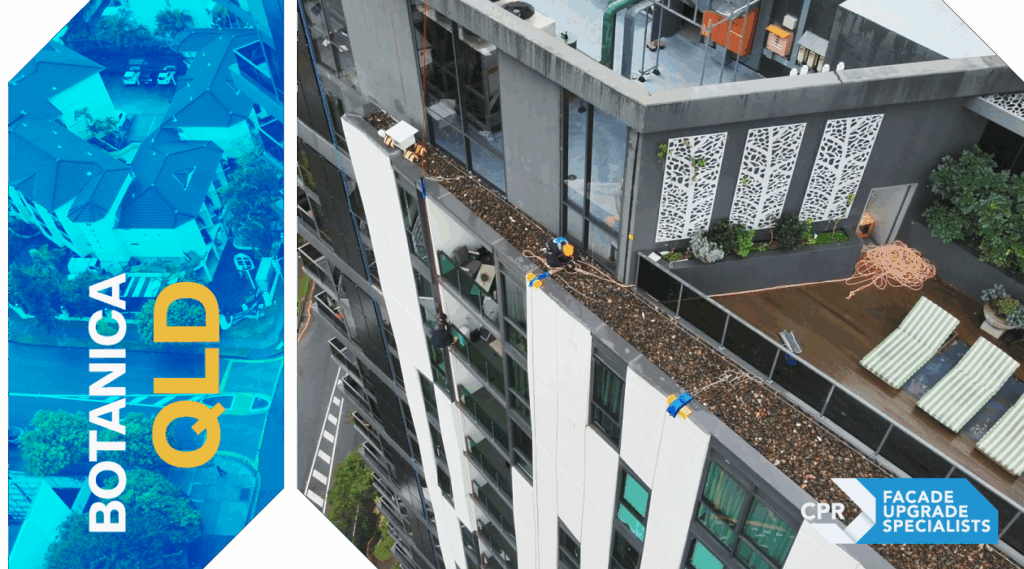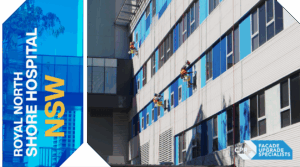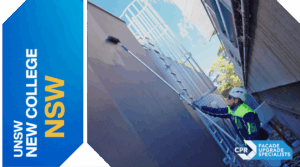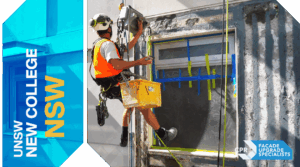Modern apartment buildings might look sleek and sophisticated on the outside, but behind the paint and panels often hide serious and costly construction issues. These apartment building defects are more than aesthetic inconveniences—they threaten safety, structural integrity, and long-term value. With apartment towers continuing to rise across New South Wales and beyond, identifying common building defects has become crucial for owners, strata committees, and building managers.
In this guide, we explore the five most common (and dangerous) defects in modern apartment buildings and how CPR’s Scaffold-Free™ solutions, SKY-FIMMS™ digital platform, and award-winning remedial expertise can help detect, remediate, and prevent them.
1. Water Leaks in Apartments: The Silent Destroyer
Among the most frequent and insidious construction defects in apartments are water leaks. They often begin subtly—behind walls, under balconies, or through poorly sealed window joints—but their effects can escalate rapidly.
Why It Happens: Poor waterproofing during construction, low-quality membranes, and neglected maintenance.
Why It Matters: Persistent leaks can cause corrosion of reinforcement steel (rebar), damage to finishes, mould growth, and eventually structural weakening.
How CPR Helps: CPR’s Scaffold-Free™ systems—MARS™, PEARS®, and SkyPod®—enable close-up inspections of every joint and surface without the need for scaffolding, ensuring faster detection and less disruption. Through SKY-FIMMS™, every leak is mapped, photographed, and digitally documented—which means for you complete transparency, accurate diagnosis, and lasting peace of mind.
For ongoing protection, CPR’s AssetCare™ maintenance program ensures long-term waterproofing performance across your building’s lifecycle.
2. Concrete Cracking Issues and Spalling: The Costly Core Problem
Concrete cracking and spalling are not just cosmetic problems; they are among the most dangerous apartment defects. Once cracks penetrate deep into the concrete, moisture reaches the reinforcement steel, triggering corrosion and expansion.
Why It Happens: Poor concrete mix design, insufficient cover to reinforcement, and thermal or shrinkage stresses.
Why It Matters: Spalling weakens the building’s load-bearing capacity and can result in falling debris—posing serious safety risks.
How CPR Helps: Our rope access inspection teams conduct comprehensive condition surveys using SkyPod® workstations, allowing precise identification of cracks and defects. Each finding is logged in SKY-FIMMS™, creating a permanent 3D record for engineers and committees to review. CPR’s concrete repair specialists use premium materials and advanced restoration methods under our Accredited Service Partners™ (ASP’s™) quality framework—which means for you safer, longer-lasting repairs and measurable cost savings.
Learn more about our concrete repair and durability services

3. Structural Issues in Modern Buildings: Hidden Dangers in the Framework
The boom in high-rise developments has brought speed—but sometimes at the cost of precision. Structural issues can stem from design flaws, material inconsistencies, or poor supervision during construction.
Common Signs: Cracks in beams or slabs, uneven settlement, or movement joints widening over time.
Why It Matters: Structural integrity is non-negotiable. Small errors in load transfer or reinforcement detailing can lead to long-term instability.
How CPR Helps: Through SFS360® (Sky Facade Scope 360®), CPR conducts a meticulous, grid-based assessment of the entire façade. This ensures no structural defect goes undetected. When remediation is required, our SE2EPC® (Sky End 2 End Project Care®) process ensures every phase—from diagnosis to rectification—is managed with engineering precision and full traceability.
Which means for you: complete project certainty, lower risk, and verified safety compliance across all stages.
4. Poor Construction Quality and Defective Materials
Behind many modern apartment defects lies one root cause—poor construction quality. Whether through inadequate supervision, cost-cutting, or substandard materials, such shortcuts eventually surface as serious building safety problems.
Typical Issues: Inadequate reinforcement, inferior sealants, faulty cladding systems, or poorly applied coatings.
Why It Matters: These lead to premature deterioration, water ingress, and expensive remediation.
How CPR Helps: As Expert Innovators, CPR combines 30+ years of experience with data-driven inspection through SKY-FIMMS™. Our rope access engineers can inspect every square metre of the façade—without scaffolding—and capture photographic evidence that forms your digital building record. Each finding is supported by a transparent report detailing severity, scope, and recommended repair.
That data-backed honesty—which means for you no guesswork, no inflated quotes, and confidence that your funds are being spent where they matter most.
Discover CPR’s Façade Preservation and Remediation Expertise
5. Building Maintenance Failures and Neglected Aftercare
Even the best-built apartments deteriorate without proper maintenance. Unfortunately, many strata committees overlook preventive maintenance until visible damage forces costly remedial works.
Why It Happens: Lack of maintenance schedules, poor record-keeping, or reactive management approaches.
Why It Matters: Neglecting regular maintenance accelerates deterioration, increases future repair costs, and can void insurance coverage.
How CPR Helps: CPR’s AssetCare™ provides long-term building preservation through scheduled maintenance, periodic SKY-FIMMS™ inspections, and proactive treatments. Our AfterCare™ service extends this further—helping committees manage future upkeep efficiently and affordably.
Which means for you: reduced long-term costs, fewer emergency repairs, and an enduring, compliant building.
Spotting Early Warning Signs: Apartment Defect Inspection Checklist
If you notice any of the following, your building could be hiding significant risks:
- Persistent dampness or mould patches on walls or ceilings.
- Rust stains or cracking on concrete surfaces.
- Doors and windows sticking or misaligned.
- Loose cladding or discolouration of panels.
- Unusual vibrations, movement, or popping sounds in walls.
Ignoring these signs could result in escalating damage and skyrocketing remediation costs. The earlier issues are identified, the safer and more affordable the solution.
Why Modern Buildings Need Modern Solutions
Traditional scaffolding-based approaches are slow, costly, and disruptive. CPR’s Scaffold-Free™ systems revolutionise access, combining MARS™, PEARS®, and SkyPod® for agile, safe, and quiet operations. Combined with the precision of SKY-FIMMS™, these technologies deliver a 360° view of your building’s health—without obstructing residents or business operations.
The result: Up to 30% cost savings, significantly reduced project timelines, and total transparency from start to finish.
A Trusted Partner in Building Preservation
CPR Facade Upgrade Specialists aren’t just contractors—we’re consultants, engineers, and innovators dedicated to redefining how Australia cares for its high-rise buildings. With Accredited Service Partners™ and award-winning QA systems, our focus remains unwavering: safety, quality, transparency, and long-term value.
Whether your building is facing visible cracks or you simply want reassurance about its condition, CPR provides the data, technology, and care to protect your investment for decades.
Ready to See Beyond the Cracks?
Book a SKY-FIMMS™ demonstration or consultation today to discover what your building may be hiding—and how CPR’s Scaffold-Free™ technology can make remediation faster, safer, and more affordable.






